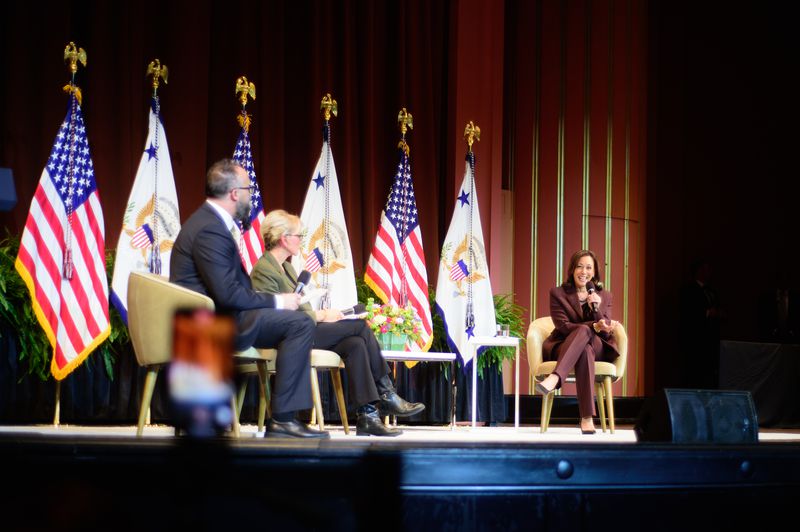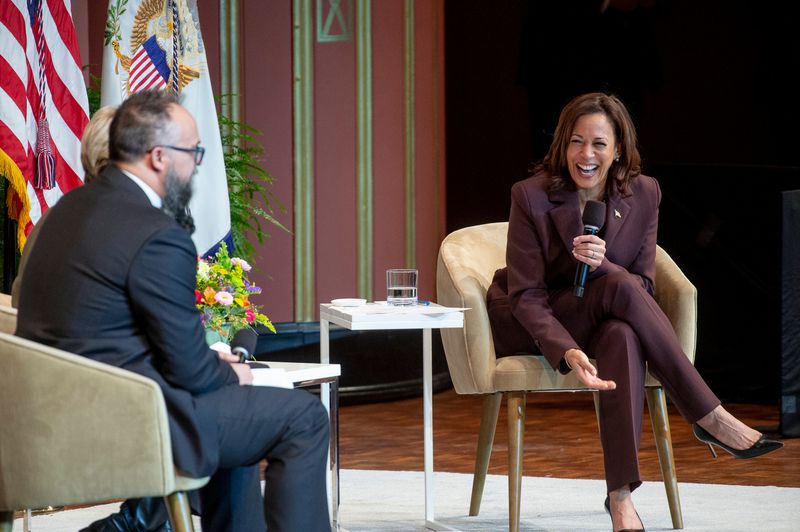In Ann Arbor, Kamala Harris focuses on climate justice.
During Vice President Kamala Harris‘ visit to Ann Arbor, the health of the world and its people took center stage.
Harris spoke alongside Secretary of Energy Jennifer Granholm and University of Michigan professor Kyle Whyte at the university’s Rackham Auditorium on Thursday, Jan. 12.

The vice president defined environmental advocacy as being fueled by both hope and crisis.
“When I think about the shoulders upon which we stand and where we have arrived, I think we should all take note of the momentum we have achieved and our responsibility, now sitting in these chairs in this moment, to then continue with this moment and lead, and not waste a minute because we don’t have a minute spare.”
During their 35-minute talk on campus, the three discussed environmental justice, new technology, and a clean energy economy to an audience of around 1,000 people from the academic, political, and environmental worlds.
Also read: Katie Porter starts her campaign to replace Feinstein in the Senate.
The discussion focussed on the effects of the climate issue and green solutions on underprivileged populations.
Whyte, a Potowatomi Nation member, has denounced the Line 5 pipeline activities, claiming that it will “damage the most holy areas” while linking Michigan to a “fossil fuel dependent energy future.” The oil and gas pipeline would be housed in a tunnel beneath Michigan’s Straits of Mackinac.
Whyte questioned the vice president where identity and the battle for equity fit into climate debates after describing how his own heritage has affected his work.
“When you look at public health inequities you need not look very hard to figure out who is affected most, usually by behaviors that they did not create,” she said.
“When you look at public health inequities, it’s not hard to find out who is most affected, frequently by habits they didn’t develop,” she added.
Harris went on to detail examples from around the country and the world of low-income and minority communities becoming “dumping grounds” for wealthier groups, who are frequently the primary pollutants. The United States is no different.]
Read Also: Kamala Harris Bio, Wiki, Career and Facts
Harris spoke about her time in Caribbean communities and witnessing the effects of US emissions, like as land erosion and harsh weather in island nations.
“Think about it from a global perspective, which is not only what do we have a responsibility to do within our country but globally? Let’s also keep in mind what we have responsibility to do in relation to our neighbors and also what we are doing to the globe as a whole,” she said.
The Biden-Harris administration modified guidance on greenhouse gas emissions declarations at the start of the new year. These disclosures will apply to new infrastructure and sustainable energy projects, including those funded by the federal government.
With an aim of reducing greenhouse gas emissions to 50-52% below 2005 levels by 2030, the Biden-Harris administration is attempting to turn back the clock on global emissions.
In doing so, the government committed to preserving 30% of the United States’ lands and waters by 2030.
President Biden has also joined the global push to achieve net-zero emissions by 2050.
The discussion on Thursday also touched on green economic advancements through research, technology, and manufacturing.
Read More: Joe Biden Bio, Wiki, Net Worth, Age, Residences and More.
Granholm hailed Michigan’s year of electrification in terms of battery development projects signed by the state.
According to a recent study, Michigan is on course to “dominate” electric vehicle battery manufacturing, as it is one of the top three states producing the most gigawatt hours by 2030.
When it came to technology, Granholm asked Harris what she was most thrilled about in a green future.
Electric school buses are at the top of the vice president’s list.
She pointed out that this technology is yet another example of the junction of public health – inhaling harmful fumes – education, and production.
“We are building a clean energy economy,” she said.
Within that new economy, the Biden-Harris administration has pledged to accept 50% more federal contracts from women and people of color-owned firms.
In her final message to the audience, she encouraged them to use the storytelling tools they already have and excel at – social media.
“Help folks get enthused about all the chances this is going to open up in the middle of adversity. Even if the crisis did not exist, which it does, it is about the dedication that our country and the globe should always have to innovation and how we can be smarter.”






